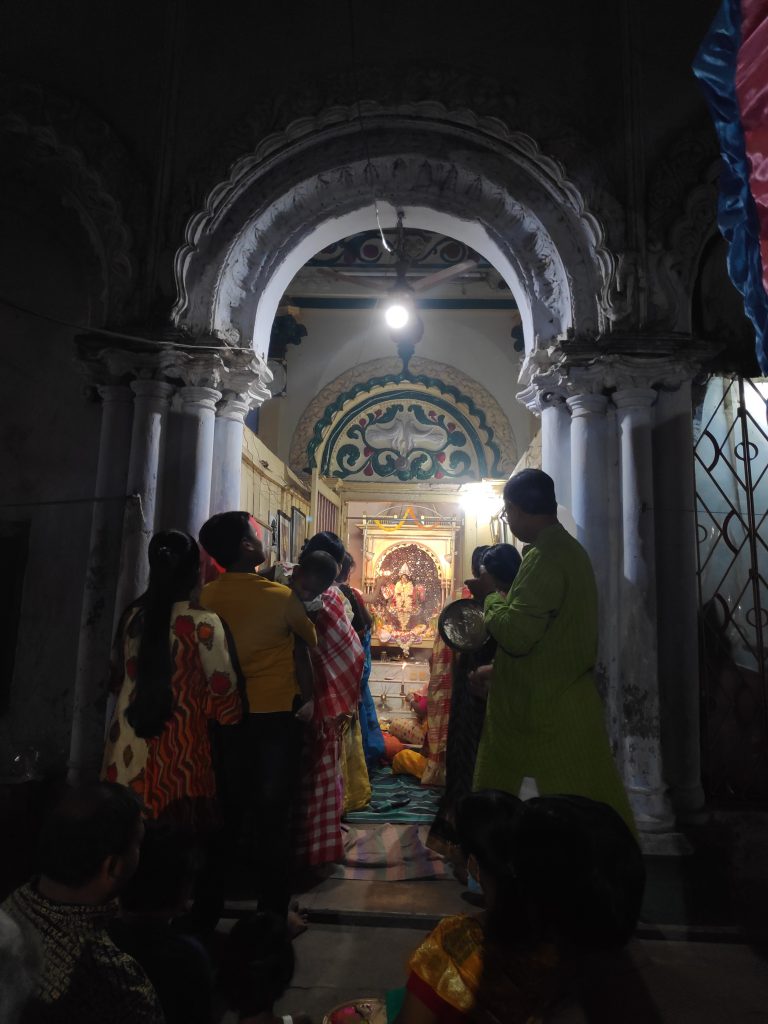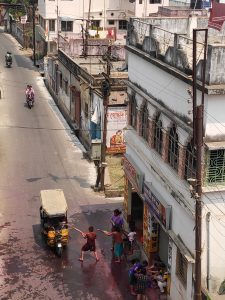All the roads lead to Nabadwip – the cradle of Gaudiya Vaishnavism – during the Dol celebrations. The old town – otherwise a residence of barely a lakh people – transforms in no time and celebrates the occasion in its characteristic fashion. It is unique. It is entirely different from the Radha-Krishna cult that culminates in Holi in the rest of India. With its focus firmly trained on the birth of Chaitanya Mahaprabhu aka Gouranga on the full-moon night, Dol in Nabadwip attains a double significance. It is Dol purnima and Gour purnima at the same breath. Since the revival of the Vaishnav cult in the mid-19th century, Dol in Nabadwip has set the standards for similar celebrations in every corner of the world where Gaudiya Vaishnavism enjoys a substantial following.
This year was no exception. Although the second wave of Covid-19 pandemic is round the corner, and the state of West Bengal is witnessing a slow but steady rise in numbers of Covid-19 patients, Nabadwip attracted several thousand devotees who make it a point to touch the soil of Nabadwip, settle in some nondescript corner of a math or mandir, join the congregation chanting ‘Bhajo Gouranga kaho Gouranga’ for hours together, and participate in countless processions charting the Nadia town with khol and kartal as accompaniments.
Colours do have a role to play. For the believers, this is just a means to remember the Vrindaban leela. For the non-believers – who have a sizeable presence in Nabadwip – spraying colours to everyone in the vicinity and bursting balloons filled with coloured waters is big-time fun on the Dol day. It runs for a few hours, roughly between ten in the morning to noon. A section of the youngsters and adults also indulge in revelry – often spurred by intoxicants. But that is merely a footnote to the fortnight-long festival that thrives on devotion. As the full-moon was sighted on 13 Choitra, i.e. 27 March, the celebrations reached the crescendo.

The Sribas Angan Road – arguably the oldest part of the town that houses several major temples including the Sribas Angan, the Samaj Bari, and the Sonar Gouranga temple – draws devotees in thousands all through the day. The Dhameswar Mahaprabhu temple – which houses the oldest idol of the spiritual leader and is run by the descendants of Vishnupriya Devi, the second wife of Chaitanya – remains the nerve-centre of the festival. The Nimai Janmasthan temple at the northern fringe of the town – which falsely claims to be the birthplace of Gouranga and showcases a renovated hut below a nim tree – has its own share of followers, too. Add to this hundreds of old and new temples and shrines run by various sects and sub-sects of Gaudiya Vaishnavism. All through the shukla paksha they wear a festive look. Kirtan is in the air 24×7. Then there is nagar sankirtana at the crack of dawn and readings from the Gita complemented by explanations in the evenings, not to mention the round the clock distribution of bhog and prasad.

With the Legislative Assembly elections on, and the Bharatiya Janata Party brand of Hindutva enjoying a free run, Nabadwip looks poised for a major transformation. This transformation has nothing to do with academic practice for Nabadwip severed almost all ties with top class scholarship over the years. It banks entirely on religion; Gaudiya Vaishnavism to be precise.
Late in the Dol afternoon, Nabadwip Puratattva Parishad – apparently the sole custodian of the town’s intellectual credentials – organized a seminar on the occasion of the ‘Sri Gouranga Dev’s 536th Birthday’. It brought together knowledgeable speakers from all walks of life – e.g. a Sanskrit scholar, a temple administrator, a school teacher, a poet, a journalist – and offered them a platform to respond to various aspects related to the occasion.

Addressing the audience, Debashis Bandyopadhyay – the Nabadwip correspondent of a leading Bengali daily – foresees a flourishing devotional tourism with Nabadwip at the nerve-centre and Mayapur playing the second fiddle. He makes no bones about ISKCON’s role in transforming the economy of Nabadwip over the last three decades. He underlines how ISKCON’s clever marketing strategy propelled a wave of nagar parikramas in the run-up to the Dol purnima day. Historians like the Parishad secretary Shanti Ranjan Deb may scoff at their blatant peddling of falsehood; but the idea of circumnavigating the landmass known as Nabadwip over a period of 7-10 days, setting up tents at strategic locations and singing the glory of the land has caught the fancy of thousands. It has gained momentum with the break-way factions of ISKCON and some old maths and ashrams of Nabadwip joining the fray; drawing in a steady flow of devotees – from far-away lands as well. Last year, some 50,000 devotees checked inside the Jal Mandir at Kolerdanga in the southern fringes of the town, the Keshabji Gaudiya Math hosted 12,000 and Debananda Gaudiya Math housed 8,000. Add to this, hundreds of maths and mandirs spread all over the length and breadth of Nabadwip. This has led to a boom in the hospitality sector. A few decades back, only the Bharat Sevashram Sangha precincts at Ampulia Para could host devotees in large numbers. Now these newly set up maths and mandirs have added guest rooms in such ferocious rapidity that at least 600 rooms are presently up for grabs. All the rooms are booked during the Dol days, Debashis adds. This figure discounts a few luxurious hotels and many ordinary lodges who continue to enjoy a steady patronage.

Insiders have come to terms with it for the two weeks leading to the Dolpurnima day rejuvenates the economy of an otherwise sleepy mofussil town and the ripple effect is felt in every aspect of economic life in Nabadwip. For instance, the idol-makers have their hands full and their numbers have increased manifold. Several hundred shops now sell dresses and accessories of the idols. Nabadwip’s century-old fame as a centre of brassware and bell-metal products also received a fresh stimulus. Now the local market supplies all the requisites for feeding a lakh devotees three times a day for so many days at a stretch. Many charitable food distribution counters, nicknamed bhandaras, join the celebrations. How would the tens and thousands navigate through the serpentine lanes and bylanes of this old town? Buses do not run within the town. The totos do. The totowallahs are having a free run during the Dol season, earning anything between 1,000 to 2,000 rupees a day. This ingenuous three-wheeler was introduced in Nabadwip as late as 2014, also during the Dol. Folklorist and singer Kalikaprasad Bhattacharya and his family enjoyed the first ride. Presently 5,000 totos crisscross the Nabadwip roads, pushing the rickshaws out of the way.
With the Legislative Assembly elections on, and the Bharatiya Janata Party brand of Hindutva enjoying a free run, Nabadwip looks poised for a major transformation. This transformation has nothing to do with academic practice for Nabadwip severed almost all ties with top class scholarship over the years.
However, the pandemic took a toll on the turn-out this time. Take the Manipur Rajbari at Tegharipara for example. Otherwise a marginal presence in the southern part of Nabadwip, the few acres of the royal palace draws thousands of devotees from Manipur during the Dol. Their processions – underscoring the century-old association of Nabadwip with the rich performing art tradition of Manipur – add a vital element to the ethnic melting pot that Nabadwip is. Before the pandemic struck, the number of Manipuri devotees swelled to over fifteen thousand. They came in buses – some 40 buses packed like sardines. Some came in trains, while some like legendary theatre director Ratan Thiyam flew in. The celebrations spilled over the streets. Not this time. Only four buses came and the celebrations were restricted within the Rajbari precincts.
But the maths and temples banking on devotees from various parts of West Bengal did not complain much; nor did the local youth. As the evening aarti at the Dhameswar Mahaprabhu temple was in full swing, and the traditional devotees were smearing each other with abir, I could spot hundreds of the young boys and girls in the crowd. They were least bothered about the ritual worship. They were busy clicking selfies, posing before the devotees with raised arms. A mile down south in Radhabazar – the central district of Nabadwip – stands the Mukhoty residence with a temple tucked inside. As the moon got fuller and fuller and the long day’s journey towards the night came to an end, a dozen odd youngsters and their friends gathered at the natmandir of the Mukhoty residence. Poet Subrata Pal, also the administrator of a Facebook community named Priyo Nabadwip, informed that the youngsters have raised a music band during the pandemic. The Dol offered them an occasion to hone their performing skills. Accompanied by a guitar, a mandolin, a violin and a drum-set, the group started with a Rabindrasangeet – ‘Phagun haoway haoway karechhi je dan’; and then switched over to a Hemanta Mukhopadhyay adhunik number – ‘Olir katha shune bakul hase’. Their music did not resonate with the spiritual verve that marked the soulful namkirtan strains coming out of Radhamadhab mandir nearby. But the spring festival came full circle with this.
Where else on earth would you find two greatest Bengalis of all time – Chaitanya and Rabindranath – vying for your attention? Where would you discover the classicists and populists competing for a place under the full-moon? Come to Nabadwip to experience syncretism.




























One Response
Hi Angshumanda, As a guy from Nabadwip, laud your coverage & analytical details of Holi ambience here. Hope to read more on Nabadwip on this platform.